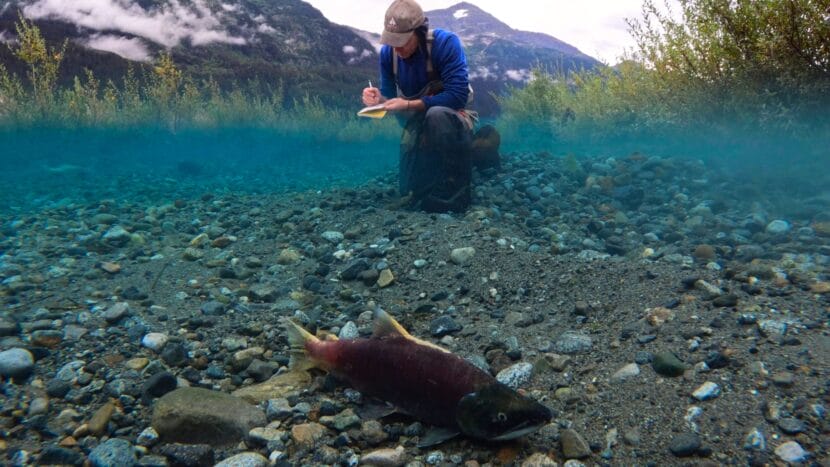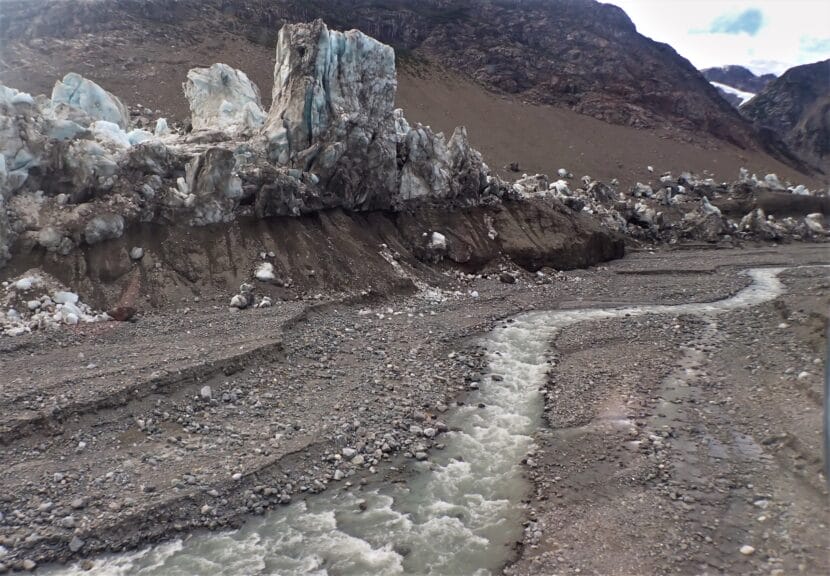
The Gitanyow nation of British Columbia has long relied on two productive salmon streams, known as the Hanna-Tintina creeks, which flow in the Nass watershed.
But back in 2016, a tribal fisheries report revealed that salmon were changing their spawning habits.
“We learned that Strohn Creek — which is called Xsik’alaa’n in our language — was actually really productive,” said Naxginkw Tara Marsden, Sustainability Director of the Gitanyow Hereditary Chiefs. “Over 40% of the spawners were in this creek, which historically had not been a producer.”
The nearby creek had not been a salmon habitat because 100 years ago, most of it was covered by a glacier.
But climate change is rapidly transforming the landscapes of western Canada and Southeast Alaska. With warming fueled by the burning of fossil fuels, many of the region’s glaciers could melt away by the end of the century.
In their wake, they’ll leave thousands of miles of brand new salmon streams. But according to a recent study published in the journal Science last November, those streams may be threatened by resource extraction before the fish even get there.

By the time salmon were discovered in Xsik’alaa’n, mining companies had already staked claims in the surrounding hillside. And the study finds that much of the region’s new salmon habitat overlaps with a mining hotspot where dozens of claims have already been staked on newly melted land.
“So we have a choice as to how we steward those nascent ecosystems,” said Jonathan Moore, a researcher at Simon Fraser University who led the study. “Are we going to protect them for future salmon habitat? Or are they going to be mined?”
Moore, Marsden and collaborators from the University of Montana and the Taku River Tlingit First Nation compared maps of glacial retreat and future salmon habitat in the transboundary region of Alaska and Canada against mining claims within a three-mile radius.
Out of 114 watersheds, they identified 25 watersheds where half the future salmon habitat overlapped with mining claims, and 17 watersheds with more than 90%.
That’s largely because many of the region’s fast-melting glaciers are within the “Golden Triangle,” a mining hotspot in Canada’s western Stikine region. As the name implies, most of the mining activity there is focused on gold.
And this modern day gold rush is facilitated by the Mineral Tenure Act, a colonial mining law that allows mining companies to get the rights for exploration and development with little consultation and a nominal fee.
Under this law, mining companies have been able to stake claims on top of glaciers that are still frozen, and on the unceded First Nations land.
If a mining claim develops into a more permanent mine, it’s subject to various environmental assessments and regulations under the Mineral Tenure Act. But those environmental laws do not mandate the consideration of climate change or future habitat.
“That’s not surprising, given how fast the world is changing and how hard it is to change policy,” Moore said. “But I think there’s an urgent need for environmental laws to look to the future and ask whether they’re protecting future habitats and not just current habitats.”
According to a recent decision by the Supreme Court of British Columbia, the Mineral Tenure Act violates Indigenous constitutional rights to stewardship too.
“The hurdle that gets created when (mining companies) stake their claims, is that then they’re owed something,” Marsden said. “We’ve stewarded these lands for tens of thousands of years, and we’re not owed anything.”
According to the court decision, the mining claims staked under the Mineral Tenure Act undermine the Canadian government’s duty to consult with Tribal nations before approving environmental permits. The province has 18 months to rewrite the Act.
Tribal governments like the Gitanyow Hereditary Chiefs hope that the province will follow their lead. In Gitanyow territory, mining in around the Hanna-Tintina creeks was already banned by the Gitanyow Lax’yip Land Use Plan in 2012.
And in 2021, they extended the same protections to Xsik’alaa’n, Strohn Creek through the declaration of the Wilp Wii Litsxw Meziadin Indigenous Protected Area.
Though Tribal governments have led the way, the study notes that it’s possible for federal or provincial governments to establish proactive protections too. In the summer of 2023, the U.S. Forest Service established a ban on mining in areas around the retreating Mendenhall Glacier in Juneau.
…
Continue reading this article at; alaskapublic.org
Author : Anna Canny, KTOO – Juneau
Alaska Public Media
https://alaskapublic.org/2024/01/09/salmon-compete-with-mining-companies-as-melting-glaciers-reveal-new-habitat/
Economy,Environment,News
#Salmon #compete #mining #companies #melting #glaciers #reveal
